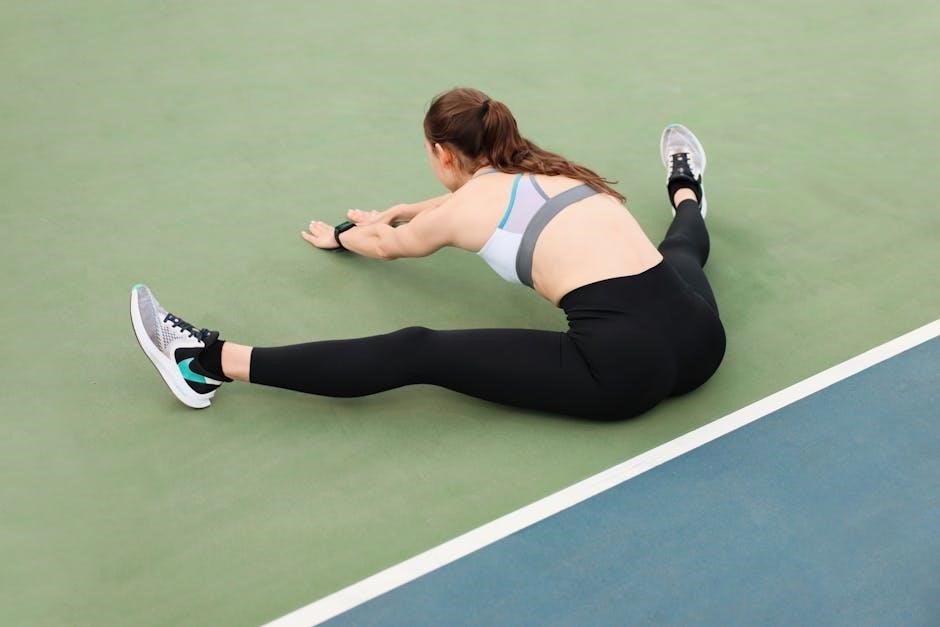Understanding Hypermobility and Its Impact on Joints
Hypermobility refers to excessive joint movement, which can lead to instability. Strengthening surrounding muscles and improving proprioception are essential for maintaining joint stability and preventing injury.
Definition and Causes of Hypermobility
Hypermobility is characterized by excessive joint movement due to loose connective tissue. It often results from genetic factors, such as Ehlers-Danlos syndrome, or developmental conditions. While common in children, joint stability typically improves with age. The Beighton score is a tool used to assess generalized joint hypermobility, focusing on specific joints like elbows, knees, and fingers. Proper diagnosis and understanding of its causes are crucial for developing targeted exercises to enhance joint stability and reduce discomfort.
The Importance of Exercise in Managing Hypermobility
Exercise is crucial for managing hypermobility, as it strengthens surrounding muscles and improves joint stability. Targeted exercises, such as core and isometric workouts, help build strength without overstraining joints. Regular physical activity enhances proprioception, reducing the risk of injuries. Consistency is key, as it promotes long-term joint health and overall well-being. Tailored routines, often guided by physical therapists, ensure exercises are safe and effective for individuals with hypermobility, addressing their unique needs and improving quality of life.

Core Strengthening Exercises for Hypermobility
Core strengthening exercises are vital for hypermobility, as they stabilize the spine and improve joint stability. Planks, bridges, and pelvic tilts enhance strength without stressing joints, promoting better movement control and reducing pain.
Benefits of Core Exercises for Joint Stability
Core exercises provide significant benefits for individuals with hypermobility by enhancing joint stability. Strengthening the abdominal and back muscles helps maintain a neutral spine position, reducing excessive joint movement. Improved stability minimizes the risk of injury and alleviates pain. Additionally, strong core muscles promote better posture and balance, which are essential for overall joint health. Regular core exercises can also enhance proprioception, the body’s ability to sense joint positions, further supporting joint stability and functional movement.
Examples of Core-Strengthening Exercises
Effective core-strengthening exercises for hypermobility include bridging, abdominal activations, and pelvic tilts. Bridging involves lying on your back and lifting your hips to strengthen the lower back and glutes. Abdominal activations, such as drawing your belly button toward your spine, enhance deep core muscles. Pelvic tilts improve pelvic floor stability. These exercises help stabilize joints and reduce excessive movement, promoting better posture and reducing pain. They are low-impact and can be done daily to build strength and support hypermobile joints.

Isometric Exercises for Joint Stability
Isometric exercises, like wall sits and pelvic tilts, strengthen muscles without joint movement, enhancing stability and reducing hypermobility-related strain. They are ideal for building strength safely.
What Are Isometric Exercises?
Isometric exercises involve contracting muscles without joint movement, making them ideal for hypermobility. They strengthen muscles and improve joint stability without risking further joint strain. Examples include wall sits and planks. These exercises are low-impact, reducing injury risk while building strength. They are particularly beneficial for individuals with hypermobility, as they enhance muscle control and stability without excessive joint stress. Regular practice can lead to improved joint support and overall physical resilience.
Examples of Isometric Exercises for Hypermobility
Examples of isometric exercises include wall sits, planks, and glute bridges. Wall sits strengthen the quadriceps without knee movement, while planks stabilize the core. Glute bridges target the hip muscles, improving pelvic stability. These exercises are low-impact, reducing joint strain while enhancing muscle strength and control. They are ideal for hypermobility as they promote joint stability without excessive movement, helping to counteract joint laxity and improve overall muscle function.
Practical Daily Exercises for Hypermobility
Daily exercises for hypermobility focus on controlled movements and minimal equipment. Examples include leg squeezes with a ball, resistance loop exercises, and bridges to strengthen hip and core muscles.
Simple Equipment-Free Exercises
Equipment-free exercises are ideal for hypermobility management. Start with bodyweight squats, focusing on proper form and controlled movements. Pelvic tilts strengthen core muscles without strain. Wall sits target quadriceps, improving knee stability. Bridging exercises enhance hip and lower back strength. These exercises promote joint stability and muscle engagement, essential for hypermobile individuals to build strength without overextending joints.
Exercises to Improve Proprioception and Balance
Exercises like single-leg stands, heel-to-toe walking, and balance board work enhance proprioception. Start with simple activities such as standing on one leg or using a soft cushion. Progress to more challenging tasks like closing your eyes while standing. These exercises improve joint awareness, reducing instability and promoting better coordination. They are essential for hypermobile individuals to maintain balance and prevent injuries.

Creating a Safe and Effective Exercise Routine
Begin with a thorough strength assessment to set realistic goals. Schedule exercises consistently, allowing rest days to prevent overexertion. Focus on gradual progression and proper form.
Assessing Strength and Setting Realistic Goals
Evaluate your current strength and joint stability to create a personalized exercise plan. Setting achievable goals helps prevent overexertion and ensures steady progress. Start with simple exercises and gradually increase intensity as strength improves. Track your progress regularly to stay motivated and adjust your routine as needed. A well-structured approach ensures safety and effectiveness in managing hypermobility.
Scheduling and Consistency in Exercise
Consistency is key to managing hypermobility. Schedule exercises 5 days a week, allowing 2 rest days for recovery. Choose times that fit your lifestyle, such as mornings or before bed, and stick to your routine. Regular practice strengthens muscles, improves joint stability, and enhances overall well-being. Tracking your progress helps maintain accountability and ensures long-term benefits from your exercise regimen.
Monitoring Progress and Adjusting Your Routine
Track your exercise progress daily, updating your tracking sheet to stay accountable. Adjust routines based on strength assessments and introduce new exercises slowly to avoid overexertion.
Tracking Exercise Progress
Tracking your exercise progress is crucial for accountability and motivation. Use a daily tracking sheet to record completed exercises, repetitions, and intensity. This helps identify patterns, strengths, and areas needing improvement. Regularly review your progress to ensure routines align with goals. Adjustments can be made based on increased strength or challenges faced. Consistent tracking fosters a clear understanding of achievements and guides future exercise planning effectively.
When and How to Introduce New Exercises
New exercises should be introduced gradually, allowing time to master current routines. Start with controlled, low-intensity movements to ensure proper form and avoid strain. Focus on building strength and stability before progressing. Consider adding isometric exercises first, as they strengthen muscles without joint movement. Always consult a physical therapist to tailor exercises to your needs. Listen to your body and avoid overexertion, ensuring a balanced and safe approach to your hypermobility management.
The Role of Physical Therapy in Exercise Planning
Physical therapy plays a crucial role in creating personalized exercise plans for hypermobility, focusing on joint stability, strength, and preventing overexertion through tailored approaches.
Working with a Physical Therapist
Working with a physical therapist is vital for managing hypermobility. They assess joint stability and strength, creating personalized exercise plans to improve proprioception and muscle control. Therapists guide patients through exercises that strengthen surrounding muscles without overexertion, ensuring proper form and technique. Regular sessions help monitor progress, adjust routines, and prevent injuries, fostering long-term joint stability and overall well-being.
Tailoring Exercises to Individual Needs
Tailoring Exercises to Individual Needs
Exercises for hypermobility must be tailored to address specific joint vulnerabilities and strength deficits. A personalized assessment identifies areas needing stabilization and strength. Core and isometric exercises are often adapted to suit individual capabilities, focusing on controlled movements to avoid overextension. Progression is gradual, ensuring exercises remain challenging yet safe. Regular monitoring allows adjustments to maintain effectiveness and prevent injury, ensuring a balanced approach to improving joint stability and overall mobility.

Common Mistakes to Avoid in Hypermobility Exercises
Overexertion and ignoring proper form are common mistakes. Pushing joints beyond safe limits can cause strain, while poor technique may lead to injury or ineffective results.
Overexertion and Joint Strain
Overexertion is a common mistake in hypermobility exercises, as it can lead to joint strain and prolonged recovery. Individuals with hypermobile joints often push too hard, exceeding their body’s limits. This can result in pain, inflammation, and instability. To avoid this, start with gentle, controlled movements and gradually increase intensity. Avoid high-impact exercises that stress the joints. Listening to your body and incorporating rest days is crucial to prevent overexertion and ensure sustainable progress in your exercise routine.
Ignoring Proper Form and Technique
Ignoring proper form and technique during hypermobility exercises can lead to muscle imbalances and increased joint stress. Poor form often results in overstretching or misalignment, which can worsen instability. It is crucial to focus on controlled movements and engage the correct muscles to avoid injury. Working with a physical therapist can help ensure proper technique. Using props or aids, like resistance bands, can also assist in maintaining alignment and preventing strain during exercises.
Regular hypermobility exercises improve joint stability, reduce pain, and enhance overall well-being. Consistent practice strengthens muscles, boosts proprioception, and promotes long-term joint health, improving quality of life.
Improved Joint Stability and Strength
Regular hypermobility exercises significantly enhance joint stability by strengthening the surrounding muscles. This increased muscle support reduces excessive movement, lowering the risk of injuries and chronic pain. Strengthening core and peripheral muscles through targeted exercises improves proprioception, the body’s ability to sense joint positions, which is crucial for maintaining balance and preventing instability. Over time, consistent practice leads to stronger, more resilient joints, enabling better overall mobility and functionality in daily activities.
Enhanced Overall Well-Being
Engaging in hypermobility exercises fosters enhanced overall well-being by reducing pain, improving posture, and boosting mental health. Strengthening core and stabilizer muscles enhances mobility and reduces fatigue, allowing for more energy in daily activities. Improved joint stability also minimizes the risk of injuries, promoting long-term independence and confidence. Regular exercise further supports better sleep quality and emotional resilience, contributing to a higher quality of life and a more balanced, active lifestyle.
